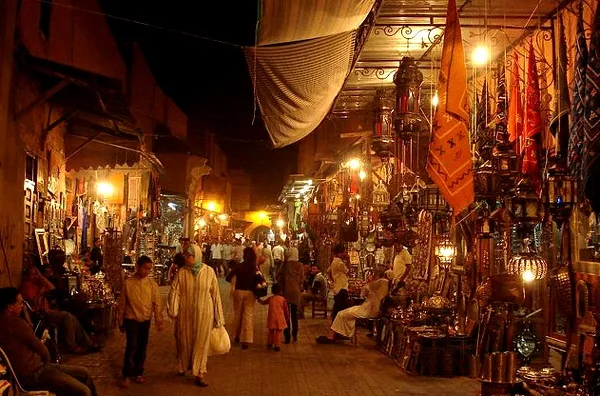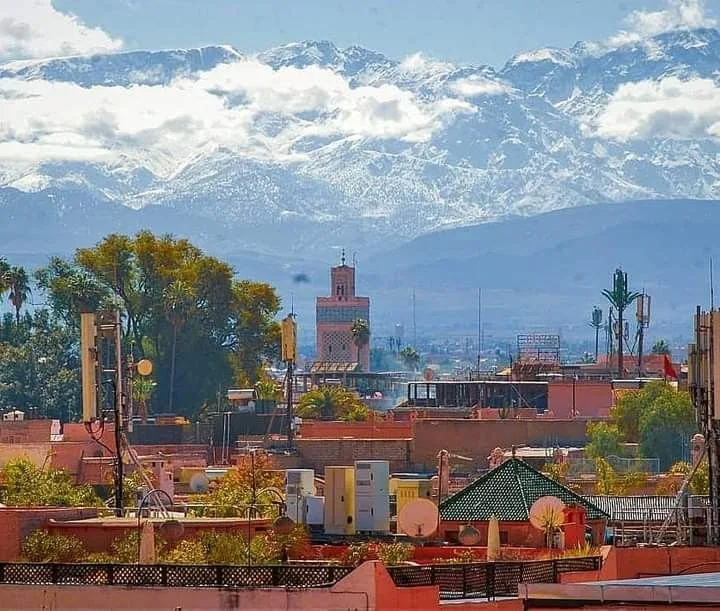Overview of Marrakech’s Climate
Marrakech experiences a semi-arid climate, characterized by hot summers and mild winters. The city is located in the northwest of Morocco, at the edge of the desert, which significantly influences its weather patterns. Here's a breakdown of Marrakech’s climate by season
Spring in Marrakech (March to May)
Spring is considered one of the best times to visit Marrakech. During this season, the city is in full bloom, with pleasant temperatures and vibrant landscapes.
Weather: Daytime temperatures range from 20°C to 30°C (68°F to 86°F), with cooler evenings. Rainfall is minimal, making outdoor activities enjoyable.
What to Do: Explore the lush gardens, such as Jardin Majorelle and Menara Gardens. Spring is also an excellent time for hiking in the nearby Atlas Mountains.
Travel Tips: Pack layers for the cooler evenings and comfortable shoes for walking tours.
Summer in Marrakech (June to August)
Summer in Marrakech is intense, with soaring temperatures that can exceed 40°C (104°F). While it may not be the most popular time for tourists, there are still ways to enjoy the city.
Weather: Days are hot and dry, while nights bring some relief with cooler breezes.
What to Do: Focus on indoor attractions like museums and palaces during peak heat hours. Early mornings and late evenings are perfect for exploring the medina.
Travel Tips: Stay hydrated, wear light clothing, and consider accommodations with air conditioning.
Autumn in Marrakech (September to November)
Autumn rivals spring as one of the best times to visit Marrakech. The weather is warm but not overwhelming, and the city’s energy is vibrant.
Weather: Daytime temperatures range from 25°C to 35°C (77°F to 95°F), gradually cooling as the season progresses.
What to Do: Enjoy camel rides, hot air balloon adventures, and trips to the desert. Autumn is also a great time to experience traditional festivals.
Travel Tips: Book accommodations and activities in advance, as this season sees a surge in tourists.
Winter in Marrakech (December to February)
Winter in Marrakech is mild, making it an ideal escape for travelers from colder climates.
Weather: Daytime temperatures hover around 18°C to 22°C (64°F to 72°F), with chilly evenings. Snow is rare in Marrakech but can be found in the nearby Atlas Mountains.
What to Do: Visit historical landmarks, such as Koutoubia Mosque and Bahia Palace. Take a day trip to the snow-capped Atlas Mountains for skiing or trekking.
Travel Tips: Pack warm clothing for the evenings and early mornings.
Factors to Consider When Planning Your Trip
Festivals and Events
Marrakech hosts several cultural and religious festivals throughout the year. Timing your visit to coincide with these events can enrich your experience.
Ramadan: This holy month is observed by Muslims worldwide, including in Marrakech. While some businesses may operate on limited hours, the city takes on a unique and serene ambiance.
Marrakech International Film Festival: Held annually in November or December, this event attracts global cinema enthusiasts.
Month-by-Month Guide to Marrakech Weather
January
Weather: Cool and dry, with average highs around 18°C (64°F).
Best Activities: Sightseeing, visiting museums, and exploring the medina.
February
Weather: Slightly warmer than January, with highs of 20°C (68°F).
Best Activities: Hiking in the Atlas Mountains and enjoying the almond blossom season.
March
Weather: Spring begins, with temperatures rising to 23°C (73°F).
Best Activities: Exploring gardens, taking camel rides, and enjoying outdoor cafes.
Packing Tips for Marrakech
Spring and Autumn: Light layers, sunscreen, and comfortable walking shoes.
Summer: Breathable clothing, a hat, sunglasses, and plenty of water.
Winter: Warm jackets, scarves, and gloves for chilly evenings.
Seasonal Activities and Highlights
Spring in Marrakech
Spring, spanning from March to May, is a delightful time in Marrakech. The weather is perfect for outdoor exploration, with temperatures warm enough to enjoy the city without the overwhelming heat of summer.
During this season, the city bursts into life, and the gardens are at their most vibrant. Visitors can witness blooming flowers and lush greenery at places like Jardin Majorelle or the Agdal Gardens. If you're an adventure seeker, spring is the ideal time to hike the Atlas Mountains or enjoy a day trip to the Ouzoud Waterfalls.
This season is also a fantastic time to visit the bustling souks, where you can shop for handmade crafts, traditional Moroccan rugs, and intricate jewelry. The mild weather makes navigating the winding alleys of the medina much more comfortable.
Summer in Marrakech
Summer, from June to August, can be challenging for visitors unaccustomed to high heat. However, for those willing to embrace the season, Marrakech offers unique opportunities to experience its culture in a quieter and more relaxed atmosphere.
Escape the midday heat by exploring the cool interiors of historical landmarks like the Bahia Palace or the Saadian Tombs. Many riads (traditional Moroccan houses) and luxury hotels feature refreshing swimming pools and shaded courtyards, providing a serene retreat.
For a truly magical experience, venture into the nearby Agafay Desert in the evening. Temperatures drop significantly at night, allowing you to enjoy camel rides or quad biking under the starlit sky.
Autumn in Marrakech
As September rolls in, Marrakech experiences a gradual cooling of temperatures. Autumn is a fantastic time for cultural immersion, with vibrant markets, music festivals, and traditional Moroccan ceremonies filling the city with life.
The Djemaa el-Fna square is particularly enchanting during this time. From henna artists to street performers and food vendors, the square transforms into a lively hub of entertainment.
Additionally, autumn is perfect for exploring Morocco's desert landscapes. From guided tours to overnight stays in Berber tents, this season allows visitors to enjoy the Sahara’s golden dunes in comfort.
Winter in Marrakech
Winter is a peaceful and enchanting time to visit Marrakech. The cooler temperatures make exploring the city on foot a pleasant experience. Stroll through the medina and marvel at the intricate details of Moroccan architecture, such as the Koutoubia Mosque or Ben Youssef Madrasa.
One of the highlights of winter is the proximity to the Atlas Mountains, which become a haven for skiing and snowboarding enthusiasts. Day trips to the Ourika Valley or Imlil village provide opportunities to enjoy the snow-covered peaks while still returning to the warmer climate of Marrakech by evening.
Weather Variability Across Regions in Morocco
While Marrakech is the primary focus, it’s worth noting that Morocco’s diverse geography results in varied climates across the country.
The Coastal Areas: Cities like Essaouira and Casablanca experience milder weather due to the Atlantic Ocean. Even during summer, temperatures are more bearable, making these regions popular for beach lovers.
The Atlas Mountains: Cooler than Marrakech year-round, the Atlas Mountains provide an excellent escape for those seeking adventure or respite from the heat
The Sahara Desert: With scorching summers and chilly winters, the desert offers extreme climates but unforgettable experiences, such as camel treks and stargazing
Travel Planning Tips Based on Weather
Peak Seasons: Spring and autumn are the busiest times, so booking accommodations and activities well in advance is recommended.
Low Seasons: While summer sees fewer tourists due to the heat, it’s a great time for budget travelers to snag deals on luxury accommodations and tours.
Clothing Recommendations: Regardless of the season, lightweight, modest clothing is ideal for respecting Moroccan culture and staying comfortable
How Weather Influences Marrakech's Attractions
The climate directly impacts how you’ll experience some of Marrakech’s most iconic attractions. For example:
Gardens and Parks: Spring is the best time to visit lush gardens like Jardin Majorelle and Le Jardin Secret. The flowers are in full bloom, creating a stunning visual display.
Souks: The bustling markets are enjoyable year-round, but cooler seasons make it easier to spend extended periods browsing without overheating.
Desert Excursions: Late autumn through early spring offers the most comfortable conditions for desert adventures, as summer temperatures can be extreme.
Sustainable Travel Tips for Marrakech
Visit Off-Peak Times: Traveling during the less crowded months (like early summer or winter) helps reduce over-tourism and supports the local economy year-round.
Support Local Businesses: Opt for accommodations and tours run by locals, which ensures your money benefits the community.
Eco-Friendly Practices: Minimize your environmental footprint by using reusable water bottles, avoiding plastic bags, and choosing eco-conscious tour operators
Best Time for Photography in Marrakech
For photography enthusiasts, the time of year can significantly impact the quality of your shots.
Golden Hour: The hours around sunrise and sunset offer the best lighting for capturing Marrakech’s vibrant colors and architectural details.
Spring and Autumn: These seasons provide the best natural lighting and clear skies, making your photos more dynamic
Seasonal Moroccan Cuisine
Marrakech’s culinary scene is deeply connected to its seasons. Spring and summer bring an abundance of fresh fruits and vegetables, while autumn and winter feature heartier dishes, such as harira soup and slow-cooked tagines.
Enjoy seasonal delicacies like fresh figs in late summer or pomegranates in autumn. No matter the time of year, sipping traditional Moroccan mint tea is a must!
Choosing the Perfect Time for Your Marrakech Adventure
The best time to visit Marrakech ultimately depends on your preferences and priorities. Whether you’re drawn to the vibrant blooms of spring, the cultural festivities of autumn, or the peaceful ambiance of winter, Marrakech offers something for every traveler.











.png)

